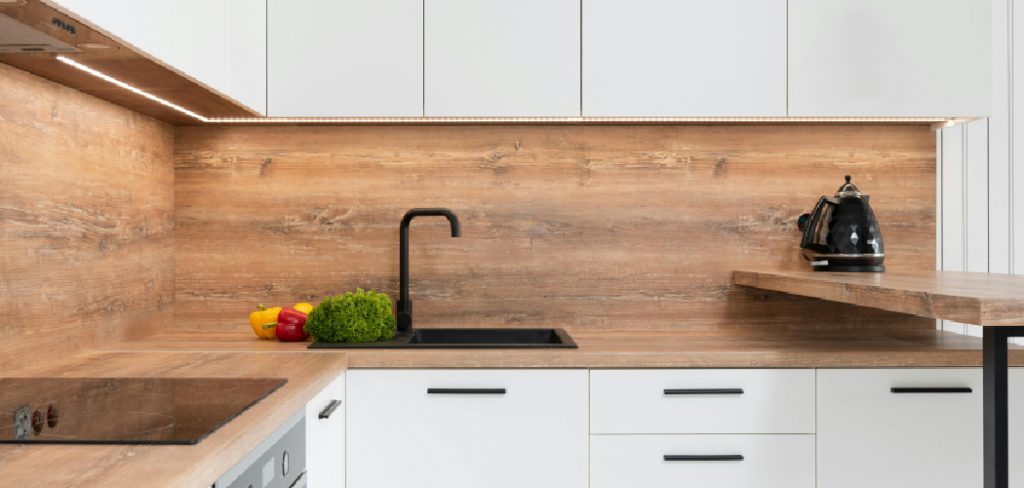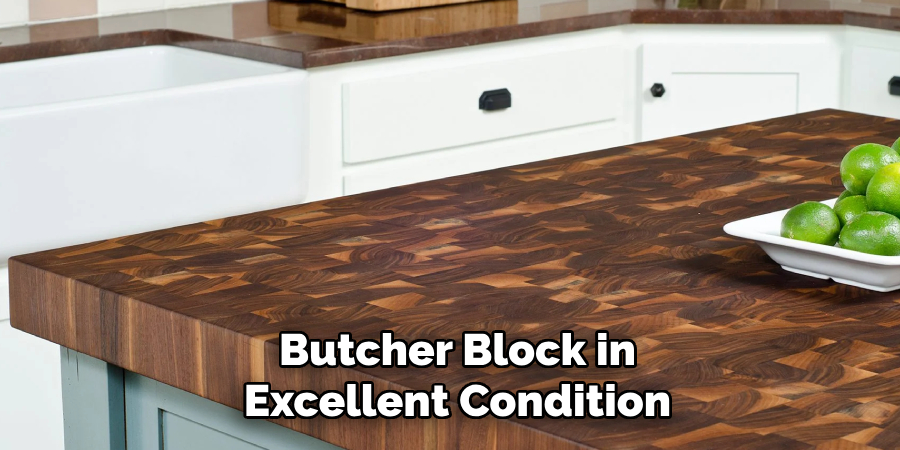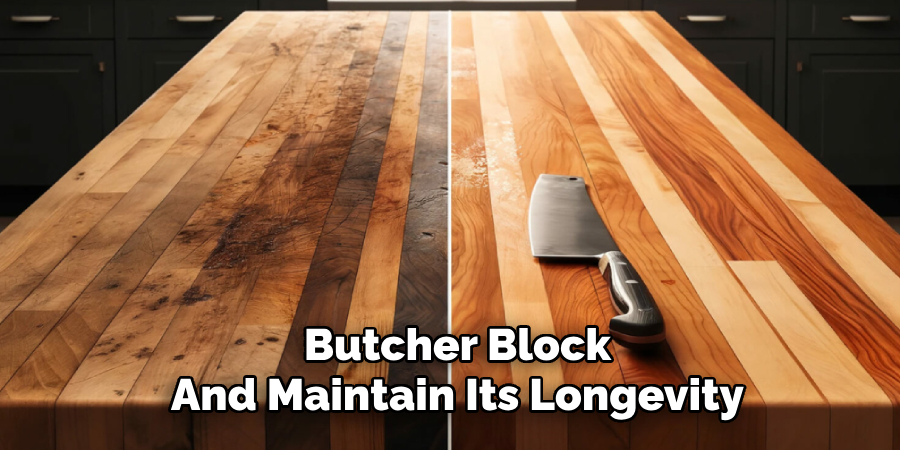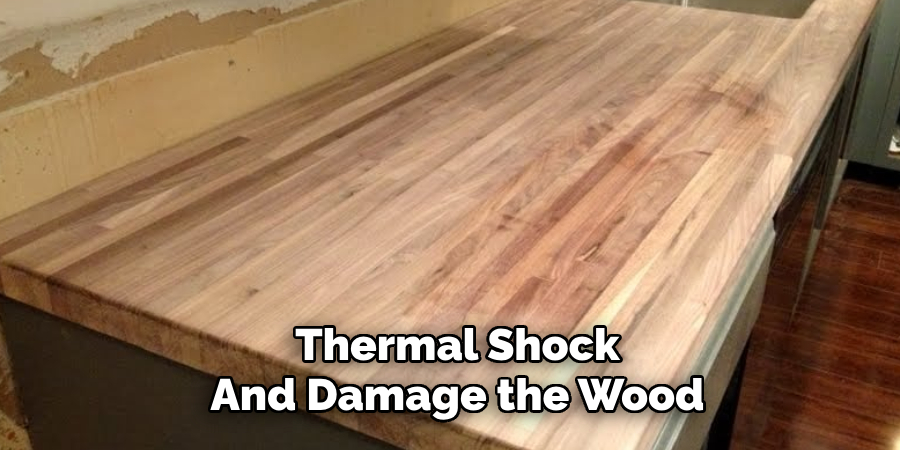Are you tired of seeing your butcher block countertop dirty and greasy? A clean and well-maintained butcher block not only looks good, but it also helps prevent bacteria growth.

How to clean a butcher block countertop is essential for maintaining its functionality, appearance, and hygiene. Whether used for food preparation or as a decorative feature in your kitchen, butcher block surfaces require proper care to prevent stains, bacteria, and damage. Additionally, cleaning a butcher block is not a difficult task and can be easily incorporated into your regular cleaning routine.
By following a few straightforward cleaning steps and performing regular maintenance, you can ensure your countertop remains safe and beautiful for years. Let’s dive into the details of cleaning a butcher block countertop.
What Are the Benefits of a Butcher Block Countertop?
Before we dive into the cleaning process, let’s quickly discuss why having a butcher block countertop is beneficial.
- Durability: Butcher block countertops are made from solid wood and are highly durable, making them perfect for chopping, cutting, and preparing food.
- Versatility: They can be used as a functional work surface and a decorative feature in your kitchen, adding warmth and character to the space.
- Eco-friendly: Unlike other materials like granite or quartz, butcher blocks are environmentally friendly as they come from sustainable sources.
- Easy on Knives: The soft nature of wood makes it easier on your knives, preventing them from becoming dull quickly.
- Affordability: Compared to countertop materials, butcher blocks are relatively affordable and can often be installed as a DIY project.
Now that we understand the benefits of having a butcher block countertop, let’s move on to how to keep it clean and well-maintained.
What Will You Need?
Before you start cleaning, make sure you have the following items on hand:
- Warm water
- Dish soap or mild detergent
- White vinegar
- Lemon juice
- Baking soda
- Clean cloth or sponge
- Soft-bristled brush (optional)
Once you have all the necessary items, let’s move on to the cleaning process.
8 Easy Steps on How to Clean a Butcher Block Countertop
Step 1: Initial Cleaning
Start by removing any items or debris from the countertop. Use a clean cloth or sponge soaked in warm, soapy water to wipe down the surface gently. Focus on removing crumbs, spills, and general dirt. Be sure to wring out excess water from the cloth or sponge, as excessive moisture can damage the wood over time.

For areas with stuck-on residues, apply a bit more pressure or use a soft-bristled brush to scrub gently. Once the surface is clean, take a dry cloth to wipe away any leftover moisture, ensuring the butcher block is thoroughly dry before moving on to the next steps.
Step 2: Address Stains
For stubborn stains or discoloration, create a paste using baking soda and a small amount of water. Apply the paste directly to the stained area and gently scrub using a soft-bristled brush or cloth in circular motions. If the stain persists, add a few drops of lemon juice or white vinegar to the paste for extra cleaning power. Allow the mixture to sit on the stain for a few minutes before wiping it away with a damp cloth. Finish by drying the area with a clean, dry cloth.
Step 3: Sanitize the Surface
After cleaning and addressing any stains, sanitizing the butcher block is important to eliminate bacteria and ensure it is food-safe. Mix a solution of one part white vinegar to four parts water, or use a food-safe sanitizer specifically designed for wood surfaces. Lightly spray or apply the solution across the entire butcher block surface. Allow it to sit for a few minutes to work effectively, then wipe it down with a clean, damp cloth. Finally, dry the surface thoroughly with a dry towel to prevent moisture from soaking into the wood.
Step 4: Condition the Butcher Block
To maintain the longevity and appearance of your butcher block, it is essential to condition the wood regularly. Use a food-safe mineral oil or a specialized butcher block conditioner to hydrate the wood and prevent cracking. Apply a generous amount of oil to the surface, spreading it evenly with a clean cloth or brush. Allow the oil to soak into the wood for several hours or overnight for deep conditioning. Wipe off any excess oil with a dry, lint-free cloth, and your butcher block will be nourished, protected, and ready for use.
Step 5: Regular Maintenance
Establish a routine of regular maintenance to keep your butcher block in excellent condition. Clean the surface after each use to avoid residue buildup, and sanitize it periodically to eliminate bacteria. Reapply a food-safe mineral oil or conditioner every few weeks, mainly if the block is used frequently.

Inspect for any signs of damage, such as deep cuts or cracks, and gently sand down the affected area before reconditioning. Consistent care will ensure your butcher block remains a durable and attractive surface in your kitchen for years to come.
Step 6: Handling Stains and Odors
Over time, your butcher block may develop stains or retain odors from certain foods. To address stains, apply a paste using baking soda and water to the stained area, and scrub gently with a soft sponge or cloth. For persistent odors, sprinkle the surface with coarse salt and rub it with half a lemon, allowing the natural acidity to neutralize lingering smells. Wipe the surface clean with a damp cloth and dry thoroughly. Properly handling stains and odors will keep your butcher block fresh and ready for a variety of culinary tasks.
Step 7: Use Cutting Boards and Trivets
Always use cutting boards for chopping, slicing, and dicing to protect your butcher block and maintain its longevity. This not only prevents direct cuts or gouges on the butcher block surface but also helps minimize wear caused by repeated knife usage. Opt for durable cutting boards made of wood or plastic, as these materials are gentle on your knives and effective for food preparation.

Similarly, always place hot pots, pans, or baking sheets on trivets or heat-resistant pads instead of setting them directly on the butcher block. High temperatures can scorch or discolor the wood, causing irreparable damage to the surface. By incorporating these simple practices into your daily routine, you can preserve the aesthetics and functionality of your butcher block for years to come.
Step 8: Be Gentle with Knives
When using your butcher block, handling knives carefully is essential to avoid accidental surface damage. Avoid forcefully chopping through tough foods directly on the block, as this can leave deep gouges or dents that may be difficult to repair. Instead, use a cutting board as a buffer or practice controlled, gentle cutting techniques. Additionally, ensure that your knives are kept sharp at all times. Dull blades require more pressure to cut, increasing the likelihood of damage to both the butcher block and your knives. Lastly, avoid repeated use of serrated or highly abrasive blades directly on the surface, as these can cause excessive wear over time.
By following these steps and incorporating proper care into your routine, you can maintain the beauty and functionality of your butcher block for many years.
5 Things You Should Avoid
- Using Harsh Chemicals: Avoid cleaning your butcher block countertop with bleach, ammonia, or other harsh chemicals. These can damage the wood surface and leave toxic residues that may come into contact with food.
- Letting Water Sit: Never allow water to puddle or sit on the surface for extended periods. Excess moisture can cause the wood to warp, crack, or develop mold.
- Using Steel Wool or Abrasive Pads: Avoid scrubbing the countertop with steel wool or overly abrasive materials, as these can scratch the surface and weaken the protective sealant.
- Ignoring Stains or Spills: Do not leave spills or stains unattended, especially liquid spills like wine or oil, as they can penetrate the wood and cause permanent discoloration.
- Skipping Regular Maintenance: Avoid neglecting regular maintenance like oiling or resealing the butcher block. Failing to do this can dry out the wood and reduce its lifespan.
Can You Put Hot Pans on a Butcher Block?
Yes, you can place hot pans on a butcher block countertop. However, doing so regularly or for long periods is not recommended.
Butcher block countertops are made from natural wood and are not heat-resistant like granite or quartz. Placing hot pans on the surface can cause thermal shock and damage the wood. It can also leave burn marks or discoloration.

It is best to use trivets or pot holders under hot pots and pans to protect the surface of your butcher block countertop. If you accidentally place a hot pan on the surface, quickly remove it and wipe the area with a damp cloth to prevent any potential damage.
Regularly oiling your butcher block countertop can also help protect it from heat damage by keeping the wood moisturized and less prone to cracking or warping.
Conclusion
How to clean a butcher block countertop is essential for maintaining its appearance and ensuring it remains functional for years to come.
To clean your butcher block, wipe the surface with a damp cloth to remove crumbs and spills. For deeper cleaning, use a mixture of mild dish soap and warm water or a solution of white vinegar diluted with water to sanitize the surface. Avoid harsh chemicals or abrasive cleaners, as these can damage the wood. After cleaning, always dry the surface thoroughly to prevent moisture from seeping into the wood. Regular maintenance, such as oiling and sealing, will protect your countertop from stains, cracks, and bacteria.
Following these steps ensures your butcher block stays clean, beautiful, and durable over time.
Professional Focus
Angela Ervin, a former interior designer turned blogger, specializes in kitchen design and renovations. Through her website, she blends her passion for cooking with design expertise, sharing practical and creative ideas. Known for balancing functionality and beauty, Angela’s insightful content has made her a trusted voice in home design and lifestyle.
About the Author
Angela Ervin, an experienced interior designer and blogger, combines her passion for kitchen renovations with storytelling. Living in Petersburg with her family, she enjoys cooking and testing her projects firsthand. Known for her humor and relatable style, Angela shares creative, functional design insights through her content, making her a trusted voice in home design.
Education History
University: Virginia Commonwealth University
Degree: Bachelor of Fine Arts (BFA) in Interior Design
- Angela’s education at VCU focused on mastering core interior design principles, including spatial planning, color theory, materials selection, and sustainable design practices.
- She gained hands-on experience through studio projects and collaborative design exercises, which honed her ability to create functional and aesthetically pleasing environments.
- Her coursework also emphasized problem-solving and practical applications of design, preparing her for real-world projects like her self-directed kitchen renovations.
- The program’s strong foundation in both technical skills and creative expression shaped Angela’s ability to seamlessly integrate form and function in her work.
